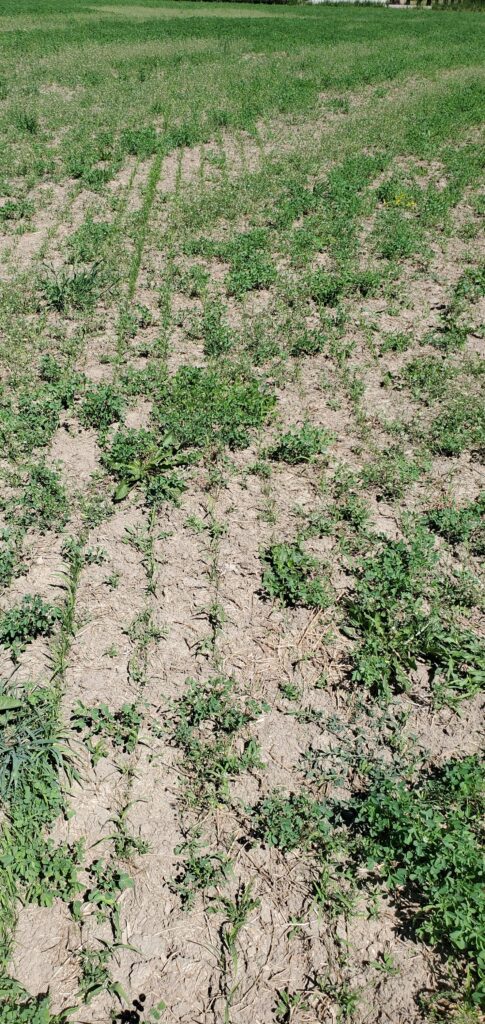Winter 2021/2022 Conditions
Fall of 2021 was very open, and many hay fields grew significantly more than usual. Stands that were predominantly grass created a higher risk for smothering alfalfa where there was too much top growth. Ideally grasses should be mowed to 15 cm (6 in.) to reduce smothering risk. Alfalfa will not smother, so fall growth can be left standing over winter. Average to above-average precipitation between November 1, 2021 and March 31, 2022 in northwestern Ontario started the process of recharging groundwater reserves following the 2021 drought.
Hay and Haylage
High rainfall and prolonged wet soils in the fall resulted in high levels of winterkill in Niagara, Elgin, Middlesex, and Oxford counties. Many tile-run alfalfa fields were noted, with thin or dead patches between tiles and some problems with weed encroachment (Figure 1). Variable stem height and maturity was also seen in these fields. In general, fields that suffered winterkill damage tended to be in the third production year and beyond. The rest of the province had normal or below-normal amounts of winterkill.

High fertilizer prices caused many growers to skip applications on their crops. It was very apparent which fields had received good fertility in the past and could cope without those nutrients this year compared to fields where fertilizer applications had been low or inconsistent in the past.
First cut started 1-2 weeks later than normal across most of the province due to cool and/or wet conditions. A derecho hit Ontario on May 21st, with the worst damage in Eastern Ontario. Most forage crops were immature enough to avoid lodging from the high winds. Storm debris had to be removed from hay fields before first cut could begin.
Alfalfa weevil was a challenge in both first and second cut crops. The cool spring allowed the weevils to get ahead of their natural enemies that normally keep them in check. The southwest struggled with dry conditions and low yields through the summer. Rains returned to most parts of the region in August, which enabled good regrowth on stands. Many fields were cut during the fall rest period to boost forage inventories. In contrast, areas east of Kingston had few windows for making dry hay. First cut yields in this region were strong, and some farms were able to fill their silos with first cut alone. Many fields went unharvested for the rest of the year, since there was no space to ensile the crop, and no good drying windows to make hay for sale.
Pasture
Pasture production followed rainfall patterns across the province. In the spring, producers in the northwest were forced to delay turnout due to saturated soil conditions and flooding. Over the summer, some farms in the southwest ran out of pasture due to dry weather and were forced to feed hay for an extended period.
Annual Forage Crops
Temperatures for the first half of April were in line with long-term averages but remained cool in the second half of the month. This put field work about a week behind normal, although the very early spring of 2021 made this year feel later than it was.
Good hay yields across much of the province meant that fewer producers established annual forages after winter wheat (either for hay or grazing). Silage corn yields in the east were strong, but variable in the southwest due to dry weather. Bt-resistant corn rootworm is a serious pest of continuous corn and is a major threat to the silage corn supply across the province. Producers are encouraged to work with their agronomist and nutritionist to create a forage crop plan with a good crop rotation. Growers should also talk to their corn seed supplier about purchasing hybrids without below-ground protection for first- and second-year corn. More information on managing Bt-resistant corn rootworm can be found on FieldCropNews.com.
Agricorp
The Forage Rainfall plan offers coverage for established hay and pasture for insufficient rainfall and excessive rainfall. The 2022 forage growing season was favourable with a large part of the province receiving average to above-average rainfall. There were pockets, like northwestern Ontario, that received above-average rainfall particularly at the beginning of the growing season. This resulted in a slower harvest period with some quality issues in those areas.
The Forage Rainfall plan paid $5.8 million in total claims to insured producers: $2.2 million in claims for the insufficient rainfall option and $3.6 million for the excess rainfall option. The highest payout year to date was 2021 ($11 million), followed by 2020 ($8 million) and 2016 ($7.5 million). There were 51,000 acres insured under the standard and premium options of the New Forage Seeding production insurance program in 2022. Total claims paid were $831,000.
Upcoming Events
November 22-24 – Forage Focus. Free webinars, noon Eastern/11 am Central. For program and to register visit https://onforagenetwork.ca/event/forage-focus-2022/
November 29-December 2 – Canadian Forage & Grassland Association AGM and conference. Theme “Cross-Pollination: Co-Creating Ideas in the Forage Industry”. For program and to register visit https://www.canadianfga.ca/events/conference-2022/
March 7-9 – Profitable Pastures. Free webinars, 8 pm Eastern/7 pm Central. Details and registration will be made available at https://onforagenetwork.ca/events/ closer to the event.
